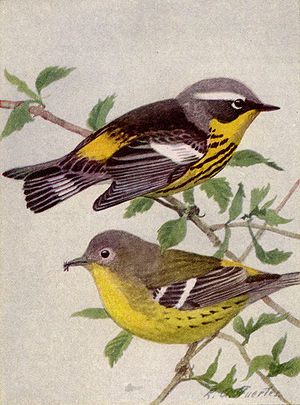National Geographic Magazine/Volume 31/Number 4/Friends of Our Forests/Magnolia Warbler
The Warblers of North America[edit]
Magnolia Warbler (Dendroica magnolia)[edit]

MAGNOLIA WARBLER
Adult and Immature Male
Range: Breeds in Canadian and upper Transition Zones from southwestern Mackenzie, southern Keewatin, northern Quebec, and Newfoundland south to central Alberta, southern Saskatchewan, Minnesota, northern Michigan, and northern Massachusetts, and in the mountains of West Virginia, Maryland, Pennsylvania, and New York; winters from southern Mexico (Puebla and Chiapas) to Panama.
The magnolia, or black and yellow warbler, as I like best to call it, is one of our most beautiful warblers, and fortunately, being one of the commonest of the tribe, is easily met with by any one willing to take a little pains. When busy at its self-imposed task of hunting insects—and when is it not busy—it is by no means shy, and may be watched at close range with or without the aid of a field glass. Whenever or however met, the sight of a full-plumaged male resplendent in the gold and black livery of spring is worth a long journey.
The bird ranges over much of eastern North America as far west as the Plains, and toward the north reaches the Mackenzie region. In the mountains it breeds here and there as far south as Maryland. In migration the magnolia shows no preference for special localities, but occurs in upland woods and lowland shrubbery where is promised a good harvest of insects. Like so many of its fellows, it finds rich hunting grounds in gray birches, and few large companies of warblers traverse gray birch woods without their complement of these beautiful and sprightly wood nymphs. The magnolia warbler is a versatile, though scarcely an accomplished, songster, and phrases its song in a number of different ways. Many of its nests have been found in the northern woods, some of them in small firs or spruces only a few feet from the ground.
Source: Henry W. Henshaw (April 1917), “Friends of Our Forests”, The National Geographic Magazine 31(4): 315. (Illustration from p. 313.)